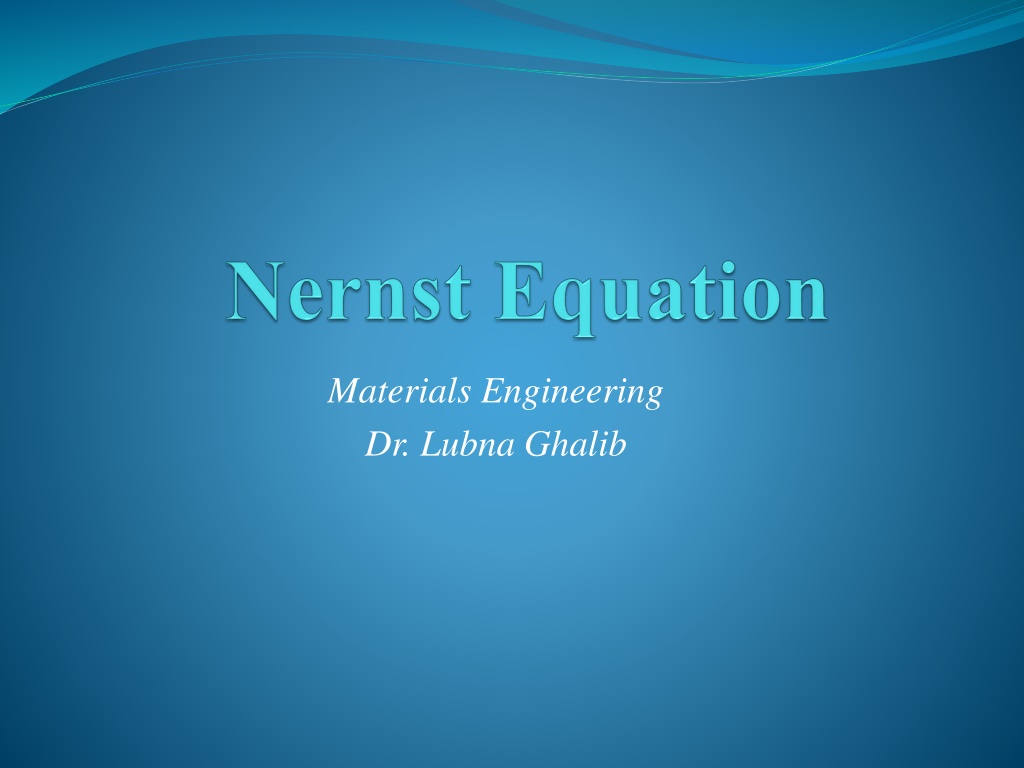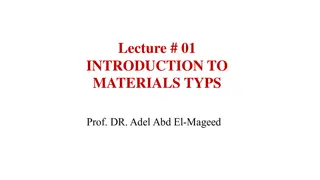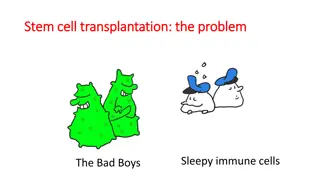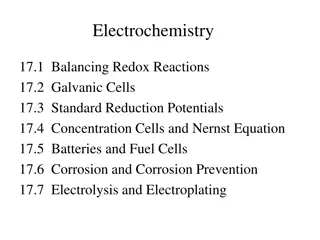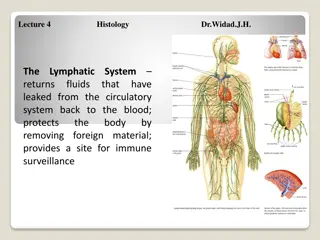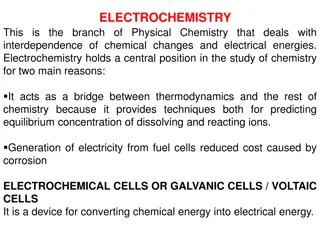Understanding Galvanic Cells in Materials Engineering
Exploring galvanic cells in materials engineering, we delve into examples involving zinc, nickel, copper, and platinum electrodes immersed in various electrolytes. By analyzing oxidation and reduction reactions, we determine electrode roles, corrosion tendencies, and cell potentials to understand the underlying principles of electrochemistry.
Uploaded on Sep 26, 2024 | 0 Views
Download Presentation

Please find below an Image/Link to download the presentation.
The content on the website is provided AS IS for your information and personal use only. It may not be sold, licensed, or shared on other websites without obtaining consent from the author. Download presentation by click this link. If you encounter any issues during the download, it is possible that the publisher has removed the file from their server.
E N D
Presentation Transcript
Materials Engineering Dr. Lubna Ghalib
Example 1: A galvanic cell consist of ( Zn ) electrode in( ZnSO4 ) solution with in( ZnSO4 ) solution with ( 1 mole ) concentration. The other is of (Ni) electrode in (NiSO4) solution with (1 mole) concentration. The two electrodes are separated with porous partition to prevent mixing of the two solutions. The two electrodes are contacted with conductive wire. Find a) On which electrode the oxidation reaction will be. b) Which electrode will be the anode. c) Which electrode will corrode. d) What is the emf for this galvanic cell, circuit close.
Example 1: Solution: The half cells reactions are: Zn2+ + 2e- Ni2+ + 2e- (a) Oxidation reaction will take place on Zn electrode .Because the potential difference in Zn half-cell more negative (- 0.763 V) compare with (-0.250 V) for Ni half Cell. (b) From previous answer, Zn electrode is the anode, because the oxidation reaction takes place on anode electrode. (c) In galvanic cell, the anode electrode is the corroded electrode, for that Zn electrode will corroded. Eo= - 0.763 V Eo= - 0.250 V Zn Ni
Example 1: Solution: (d) Cell potential is the sum of the two half cells potential. Zn2+ + 2e- Eo= + 0.763 V Anodic reaction: Zn Cathodic reaction: Ni2+ + 2e- Eo= - 0.250 V Ni Final reaction Zn + Ni2+ Zn2++ Ni Eocell= + 0.513 V
Example 2: if we connect Pt electrode with Cu electrode we get: Pt 2+ + 2e- Pt Cu2+ + 2e- Cu Eo = + 1.200 V Eo= + 0.34V By subtraction the lower potential from the higher we get Cu2+ + 2e- Pt Eo= - 0.34 V Eo = + 1.200 V Oxidation: Cu Reduction: Pt 2+ + 2e- Final : Cu + Pt 2+ Cu2+ + Pt Eocell= + 0.86 V
Example 3: If the galvanic Cell contain two electrodes, One of them with ( - ve ) potential and the other with ( + ve ), such as Zinc with Copper. Zn2+ + 2e- Zn Cu2+ + 2e- Cu Eo= - 0.763 V Eo= + 0.34 V Zn2+ + 2e- Eo= + 0.763 V Eo= + 0.34 V Eocell= + 1.103 V Oxidation Zn Reduction Final : Zn + Cu2+ Cu2+ + 2e- Cu Zn2+ + Cu
Example 4: Write the reactions of the anodic half cell (oxidation) and cathodic half cell (reduction). For the following electrodes and electrolytes, by using standards potential values: (a) Zinc and copper electrodes are immersed in dilute (CuSO4). Solution: Oxidation ( Anodic reaction ) Zn Zn2+ + 2e- Reduction ( Cathodic reaction ) Cu2+ + 2e- Cu We observed that Zinc reaction possess more negative, so it is the anode and oxidation reaction occurred on it. Eo= + 0.763 V Eo= + 0.34 V
Example 4: (b) Copper electrode is immersed in water saturated with oxygen. Solution : May be there is a low rate corrosion or maybe there is no corrosion, because the potential difference between Cu oxidation (0.337 V) and that formed in water from hydroxide ion (0.401 V) is very small. Cu2+ + 2e- Cu O2+ 2H2O + 4e- 4(OH-) Eo= + 0.34 V Eo= + 0.401 V Eo= + 0.061 V
Example 4: (c) Iron electrode is immersed in water saturated with oxygen. Solution : Iron potential's difference is more negative, so it is the anode and oxidation reaction occurred on it. Oxidation ( Anodic reaction ) Fe Fe 2+ + 2e- Reduction (Cathodic reaction) O2+ 2H2O + 4e- 4(OH- ) Eo= + 0.440 V Eo= + 0.401 V
Example 4: d) Magnesium electrode is immersed in water saturated with oxygen. Solution: Mg is more negative in potential, so it is the anode and oxidation reaction occurred on it. Oxidation ( Anodic reaction ) Mg Mg2+ + 2e- Reduction (Cathodic reaction) O2 + 2H2O + 4e- 4(OH- ) Eo = + 2.363 V Eo= + 0.401 V
Galvanic Cell : Galvanic Cell not one molar with Electrolytes that are : Most of electrolyte solutions of the real galvanic cells are not to be (1 mole ) .But they are always dilute solutions, which they are less than (1 mole ). If the ions concentrates in the electrolyte surround to the anode electrode is less than 1 mole, the reaction motive force to dissolve or corrode the anode will be higher. Because there is less concentrate of ions that causes the reverse reaction. Therefor it will be more negative of electro-chemical series on the anodic half-cell. M M z+ + ze- Truly the metal ion concentration effects (Cion) on the standards potential of the electrochemical series (Eo(at (25oC)Temperature are given by Nernst equation for the half anodic cell reaction. Where there is one kind of ions are produced.
Nernst equation : ????????? ?????????? ???+??? ?? ? = ?? ?? ??ln ? = ?? ?? ??ln ? = ?? ?? ??ln ???+ Because M and e- =1 ? = ?? 2.3038.314 ?/?.??? 25 + 273 ? ? 96500 ??????? log ???+ ? = ?? 0.0591 log ???+ ?
Nernst equation : Where: E = New electrochemical potential for the half cell. Eo = standard electrochemical potential for the half cell. n = No. of electrons transferred (the valence). Cion = molar concentrations of the ions. R = gas constant = 8.314 J/(mole.K) T = Temperature = 25 + 273 = 298 K. F = Faraday constant = 96,500 coulomb.
Electrochemical cell potential: Electrochemical cell potential for two standard half-cells that are electrically coupled A corrosion reaction can be considered as composed of two half- cell reactions. One of the half-cell reactions corresponds to 'oxidation reaction taking place on the 'anode,' and the other half cell reaction corresponds to 'reduction reaction' taking place on the 'cathode of the cell. The contribution of each half cell reaction to the Nernst expression can be derived as follows: Oxidation reaction at anode: Reduction reaction at cathode : Final reaction M1 + M2z+ M1z+ + ze- M2 M1 M2z+ + ze- M1z+ + M2
Electrochemical cell potential : ? = ?1+ ?2 ?+ ??1 ??1 ??2 ??2 ? ?? ? ?? ? = ?1 ??ln + ?2 ??ln ?+ ?+ ?2 ? as taken from the Where Eo= standard potential, ??= ?1 standard emf series. ? ?? ??ln ??1 ??2 ??2 Theses equations are Nernst equations for the half-cell reactions ?+ ??1 ?1= ?1 ? ?? ?2= ?2 ??ln ?+ ?+ ??1 ??1 ??2 ??2 ? = ?? ?? ??ln and ?+
Electrochemical cell potential : This equation is the Nernst equation for the complete cell reaction. Since metal M1 is oxidized, the sign of is opposite to that as it appears in Table of standard emf the two above equations yields and the cell potential ?? for this reaction to occur spontaneously, Must be positive; if it is negative, the spontaneous cell direction is just the reverse of equation. When standard half-cell are coupled together, the metal that lies lower in emf table will experience oxidation (i.e., corrosion), whereas the higher one will be reduced.
Electrochemical cell potential: Influence of Concentration and Temperature on Cell Potential Nernst equation electrochemical cell potential for two half-cells that are electrically coupled and for which solution ion concentrations are other than (1 mole). ? = ?? ?? ??ln Simplified the equation for T = 25oC (room temperature). ?+ ??1 ??2 ?+ ?+ ??1 ??2 ? = ?? 0.0591 l?? ?+ ?
Example 5: A galvanic cell in (25 Co) temperature it is formed from Zinc electrode in (0.10 mole ZnSO4) solution, the other electrode is of Nickel in (0.05 mole NiSO4) solution .The two electrodes are separated with porous wall and connected with external wire. What is the value of the cell potential, when the circle is connected. Solution: Ni2+ + 2e- Ni Zn2+ + 2e- Zn Zn electrode will be the anode because it s potential (- 0.763 v) is more negative in the electrochemical cell of Zn Ni than of Ni (- 0.250 v). ????4 ??2++ ??4 2 0.1M 0.1M 0.1M Eo= - 0.25 V Eo= - 0.763 V
Example 5: Solution: Ni2+ + 2e- Zn Then using Nernst equation to correct the potentials of the cell. Anode reaction ? = ?? 0.0591 ? = 0.763 0.0591 Eo= - 0.250 V Eo= + 0.763 V Ni Zn2+ + 2e- log ???+ ? log 0.1 2 = 0.763+0.0296 = 0.7926 V ? = 0.250 0.0591 ? = 0.250 0.0385 = -0.2885 V 1 log Cathodic reaction 2 0.05
Example 5: Solution: Emf of cell: = EA + EC = 0.7926 V - 0.288 V Another method: ? = ?? 0.0591 = 0.5041 V ?+ ??1 ??2 l?? ?+ ? ? = (0.763 0.250) 0.0591 0.1 0.05 log ? E = 0.513-0.00889 E = 0.50410 V
Example 6: two half-cell reactions are given below: Cu2+ + 2e- Cu Zn2+ + 2e- Zn Their reduction potentials are given opposite to each. Calculate: (a) The emf of the cell and (b) Show the spontaneous cell reaction. Solution: the lift hand electrode (Zn) is the anode and the right hand electrode (Cu) is the cathode. Therefore, zinc will undergo oxidation and copper reduction as shown below. Hence: (a)????? = ?? ????? = ??? = 0.337 + 0.763 = +1.100 volts Eo= + 0.337 V Eo= - 0.763 V ? ?+ ?? ? ? ? ?+ ???
Example 6: (b) Spontaneous cell reaction is given by: cell reaction = cathodic reaction = anodic reaction Final reaction Cu2+ + Zn From the table of standard reduction potentials, the reduction potential of Cu is +0.337 volts and that of Zn is - 0.763 volts. The emf of the cell is positive. Hence the reduction is spontaneous and it should proceed from left to right. If the position of the electrodes are now interchanged such that the copper electrode is placed on the left and the zinc electrode on the right, the sign of the cell emf will change. Here, zinc electrode being on the right is treated as cathode and the copper on the left as anode. Zn2+ + Cu
Example 6: Therefore: Eocell =-1.1 V The emf obtained is now negative which indicates that the reaction is not spontaneous and the current flows from right to left. The left hand electrode where the current originates is, therefore, the anode, and the right-hand electrode, the cathode. The polarity of the cell is, therefore, clearly established. Final reaction Zn2+ + Cu Cu2+ + Zn
Example 7: Calculate the reversible potential for a zinc electrode in contact with ZnCl2 when the activity of zinc is aZn2+ =10-3 M. Solution: We write the half-cell reaction Zn2+ + 2e- Zn Apply Nernst equation: ? 0.0591 Eo= - 0.763 V 1 ???= ??? log ? ???2+ ???= 0.763 0.0591 1 log 10 3 ? EZn= - 0.8518 V
Example 8: show that the reduction reaction given below: 2H+ + 2e- H2 EH = -0.0591 pH Solution: the reaction is 2H+ + 2e- H2. Using Nernst equation we obtain for the above reaction: ?? ??ln ????????? Changing to 2.303 log and substituting for R=8.314 j/(mol. K) F=96500 C, T=298 K 2.303RT/F =0.0591 V The Nernst expression above can, therefore, be written as: ??+/?2= ??+/?2 Now substituting pH= - ??? ?+ in the above expression we get: EH+/H2 = -0.0591 pH ???????? ? ??+/?2= ??+/?2 ? 0.0591log ?+
Example 8: Show that for the reaction: O2+2H2O+4e- 4(OH-), ? ???/?? = ???/?? ?.??????? ??? Solution: The reaction is O2+2H2O+4e- 4(OH-), (in a basic solution), and ??ln(??? )4 ?? ? ???/?? = ???/?? ??2 Note that O2 is the oxidized state and OH- is the reduced state, for the above reaction. The activity (ai) of an ion is defined by ??= ????, where Mi = molality (mol/kg) of ions in the solution, and ai is the activity coefficient. The activity coefficient aifor a given concentration can be found from a table of activity coefficients. In dilute solutions, the activity coefficient is taken to be unity.
Example 8: ??2 ??= 1, when??2= ??= 1 ???, standard state, If we take ??2= and R= 8.314 j/mol.K, F=96500 C (g.equiv.)-1and the term 2.303RT/F=0.0591, and substitute in the above expression, the oxygen electrode potential becomes: ??2/?? = ??2/?? It can similarly be shown that in acid solution for a reaction, O2+4H++4e- 2H2O, the oxygen electrode potential becomes: ?? 4?ln Substituting the values for the constants as above, we get: ??2= ??2 0.0591log??+ Or since pH= - log ??+ ??2= ??2 0.0591 ?? ? 0.0591??? ??? 2 ??2? ? ???= ??? (??2)(??+)4 ? ?
